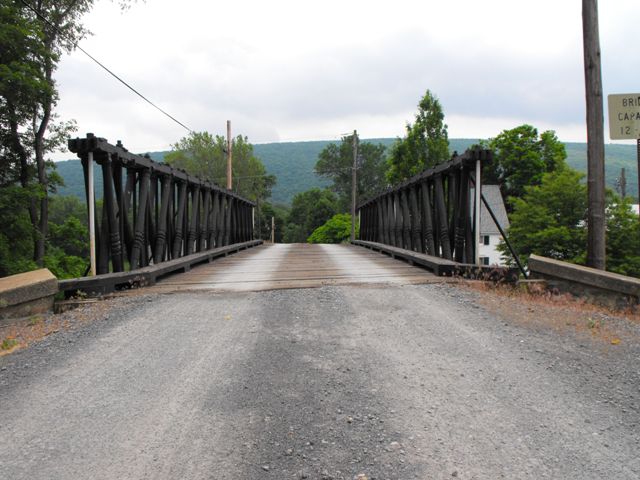We Recommend:
Bach Steel - Experts at historic truss bridge restoration.
BridgeHunter.com Phase 1 is released to the public! - Visit Now
Reading-Halls Station Bridge

Primary Photographer(s): Nathan Holth and Rick McOmber
Bridge Documented: May 29, 2010 and October 29, 2016
Muncy Township: Lycoming County, Pennsylvania: United States
1846 By Builder/Contractor: Unknown and Engineer/Design: Richard B. Osborne
1996
59.1 Feet (18 Meters)
59.1 Feet (18 Meters)
Not Available
1 Main Span(s)
Not Applicable

View Information About HSR Ratings
Bridge Documentation
View Historic American Engineering Record (HAER) Documentation For This Bridge
HAER Drawings, PDF - HAER Data Pages, PDF

The Reading-Halls Station Bridge is one of the most important historic bridges in the United States. The bridge is so exceedingly old that it was built only approximately a year after the first all-metal truss in the country, the Manayunk Iron Bridge, was built in 1845. Today the Reading-Halls Station Bridge is distinguished as the oldest active metal truss bridge in the United States. The only other older remaining truss in the country is indeed the first metal truss, the Manayunk Iron Bridge. One of the truss webs of the Manaynk Iron Bridge remains on exhibit at Smithsonian's National Museum of American History in Washington D.C. For comparison the Market Street Bridge, the oldest cast iron arch in the United States is only seven years older, having been built in 1839.
The Reading-Halls Station Bridge was designed by Richard B. Osborne, a civil engineer, for the Philadelphia and Reading Railroad. Osborne was also the designer for the aforementioned Manayunk Iron Bridge.
Although the Reading-Halls Station Bridge has been shortened three panels from its original dimensions and the end posts have been replaced, the remaining truss retains excellent historic integrity, particularly considering the bridge's age. The bridge continues to carry vehicular traffic over a Norfolk Southern railroad line for a private farm complex on a dead-end private road. The bridge itself is apparently owned by Norfolk Southern. The bridge was relocated from its original location to its current location sometime between 1884 and 1900.
The bridge displays the ornate, yet structurally functional artistry that only a cast iron bridge can display. This artistry manifests itself in the diagonal members of the bridge which are cast with Egyptian revival motifs.
Given that the bridge is owned by Norfolk Southern Railroad and serves a private drive, this bridge cannot be described to have a preservation commitment. As a private bridge, any involved owners of the bridge and road can choose to do whatever they want with the bridge without any input from the general public, including alteration or complete demolition. One can only hope that this bridge's owners realize that they possess one of the most important bridges in the entire country and that they treat it with the reverence and care that it deserves.
Be sure to read the HAER narrative (data pages) for a detailed history of this bridge and its context.
This bridge is tagged with the following special condition(s): Unorganized Photos
![]()
Photo Galleries and Videos: Reading-Halls Station Bridge
2010 Bridge Photo-Documentation
Original / Full Size PhotosA collection of overview and detail photos. This gallery offers photos in the highest available resolution and file size in a touch-friendly popup viewer.
Alternatively, Browse Without Using Viewer
![]()
2010 Bridge Photo-Documentation
Mobile Optimized PhotosA collection of overview and detail photos. This gallery features data-friendly, fast-loading photos in a touch-friendly popup viewer.
Alternatively, Browse Without Using Viewer
![]()
2016 Additional Unorganized Photos
Original / Full Size PhotosA supplemental collection of photos that are from additional visit(s) to the bridge and have not been organized or captioned. This gallery offers photos in the highest available resolution and file size in a touch-friendly popup viewer.
Alternatively, Browse Without Using Viewer
![]()
2016 Additional Unorganized Photos
Mobile Optimized PhotosA supplemental collection of photos that are from additional visit(s) to the bridge and have not been organized or captioned. This gallery features data-friendly, fast-loading photos in a touch-friendly popup viewer.
Alternatively, Browse Without Using Viewer
![]()
Maps and Links: Reading-Halls Station Bridge
Signs located at the bridge describe the bridge and road as private property.
Coordinates (Latitude, Longitude):
Search For Additional Bridge Listings:
Bridgehunter.com: View listed bridges within 0.5 miles (0.8 kilometers) of this bridge.
Bridgehunter.com: View listed bridges within 10 miles (16 kilometers) of this bridge.
Additional Maps:
Google Streetview (If Available)
GeoHack (Additional Links and Coordinates)
Apple Maps (Via DuckDuckGo Search)
Apple Maps (Apple devices only)
Android: Open Location In Your Map or GPS App
Flickr Gallery (Find Nearby Photos)
Wikimedia Commons (Find Nearby Photos)
Directions Via Sygic For Android
Directions Via Sygic For iOS and Android Dolphin Browser
USGS National Map (United States Only)
Historical USGS Topo Maps (United States Only)
Historic Aerials (United States Only)
CalTopo Maps (United States Only)


